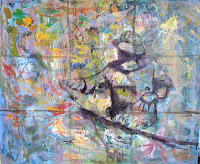I just finished reading "Richard Schmid Paints Landscapes." He is such a master. Not only are his paintings stunning, but as a teacher he also has a flair for keeping the message simple. The book is rich with information and examples. Fresh in my mind are two segments that were most meaningful at this point in my art.
The three basic compositional qualities that Schmid thinks are evident in his work are
simplicity, harmony and subtlety. He says that regardless of the size or complexity of his paintings, he strives for simplicity. Easy to say, but so hard to do. By harmony, he refers to the presence of a single pictorial element that unifies the painting, such as lighting, colors, edges, etc.. I had never heard anyone state that subtlety was desireable. If anything, I have learned to emphasize the focal point using as many compositional elements as possible, providing a dramatic center of interest. I'd like to consider what Schmid is saying. A pictorial composition that is obvious defeats is purpose. Schmid's paintings have an understated beauty that transforms it to another level.
The second topic that I found interesting relates to the benefits of painting overcast weather. Schmid prefers a high, bright overcast stating that he finds it the most stable. This kind of diffused daytime lighting is slow to change and is predictable providing a longer stretch of painting time. Schmid states that a painting done in overcast will look "right" under most indoor lighting conditions.

I was up for testing these principles today, given it was cloudy and a mild 55 degrees with no wind. The weather radar indicated that I had a couple of hours before the rain really started. I returned to the Jones River site in Kingston and set up under the open wooden shelter that covers the picnic tables. Did I say before that I love this spot?
It's mid-November so the oak trees have their burnt, reddish leaves, but the rest of the deciduous trees are bare. This photo looks pretty barren, but it really was a subtle beauty.
I mixed up some pinkish and yellowish soft grays for the sky. After the sky, I worked the dark pier pilings, progressing then from darks to lights. The oaks were burnt sienna. Grasses were raw sienna with some cad yellow deep.
Initial block in was fun and the colors seemed good. The tide was coming in, so the shiny, silver mud in the foreground quickly transformed into a mirror reflection of the pier. What had been dark river water started moving and became white ripples. So maybe the sky and shadows were not changing but, as usual, the water was.
Below is the point at which I stopped. The question is, did I hit the Schmid takeaways? Somewhat. It's hard to be objective this late.
Simplicity- fair, the far horizon is accurate with cedars, but does it pull to much because they are dark? Harmony? Yes, I think - through color palette. As for subtlety - yes, I think because the overall greyness of the day comes through. What do
you think?
Oh, and it was overcast and even raining by the end.
 |
| Jones River Rainy Day |




 I drew my grid of thirds and sketched in the farmer so that his face was at the northeast sweetspot and his brightly lit hand was on the southeast sweet spot. The worker is corralling the cranberries by pulling the rope with his right hand while detangling weeds with his left. Next I fill in his overalls and made drawing corrections.
I drew my grid of thirds and sketched in the farmer so that his face was at the northeast sweetspot and his brightly lit hand was on the southeast sweet spot. The worker is corralling the cranberries by pulling the rope with his right hand while detangling weeds with his left. Next I fill in his overalls and made drawing corrections. 

























